The NVIDIA GeForce GTX 1080 Ti Founder's Edition Review: Bigger Pascal for Better Performance
by Ryan Smith on March 9, 2017 9:00 AM ESTPower, Temperature, & Noise
As always, last but not least is our look at power, temperature, and noise. Next to price and performance of course, these are some of the most important aspects of a GPU, due in large part to the impact of noise. All things considered, a loud card is undesirable unless there’s a sufficiently good reason – or sufficiently good performance – to ignore the noise.
| GeForce Video Card Voltages | |||||
| GTX 1080 Ti Boost | GTX 1080 Boost | GTX 980 Ti Boost | GTX 1080 Ti Idle | ||
| 1.062v | 1.062v | 1.187v | 0.65v | ||
Starting with voltages, there aren’t any big surprises with the GTX 1080 Ti. The underlying GP102 GPU has the same load voltages as the GP104 GPU in the GTX 1080, resulting in a load voltage of 1.062v.
Moving on, let’s take a look at average clockspeeds. The GTX 1080 Ti’s official base and boost clockspeeds are lower than the GTX 1080’s, but as we’ve seen before with other NVIDIA video cards, the actual clockspeeds are a little more variable and almost always higher than NVIDIA’s official values. Consequently the GTX 1080 Ti’s clockspeeds may on average trail the GTX 1080 less than what the specifications say.
| GeForce Video Card Average Clockspeeds | |||
| Game | GTX 1080 Ti | GTX 1080 | |
| Max Boost Clock |
1898MHz
|
1898MHz
|
|
| Tomb Raider |
1620MHz
|
1721MHz
|
|
| DiRT Rally |
1721MHz
|
1771MHz
|
|
| Ashes |
1680MHz
|
1759MHz
|
|
| Battlefield 4 |
1657MHz
|
1771MHz
|
|
| Crysis 3 |
1632MHz
|
1759MHz
|
|
| The Witcher 3 |
1645MHz
|
1759MHz
|
|
| The Division |
1645MHz
|
1721MHz
|
|
| Grand Theft Auto V |
1746MHz
|
1797MHz
|
|
| Hitman |
1657MHz
|
1771MHz
|
|
On the whole, the GTX 1080 Ti does average lower clockspeeds than the GTX 1080. Whereas the latter would frequently average clockspeeds in the 1700MHz range, the GTX 1080 Ti averages clockspeeds in the 1600MHz range. This, in part, is why NVIDIA is promoting the GTX 1080 Ti as being 35% faster than the GTX 1080, despite the card having a 40% advantage in total hardware units.
It is interesting to note though that our GTX 1080 Ti sample has the same maximum boost clock as the GTX 1080: 1898MHz. If the GTX 1080 Ti didn’t hit its thermal limit as often, it likely would come even closer to the GTX 1080 in average clockspeeds.
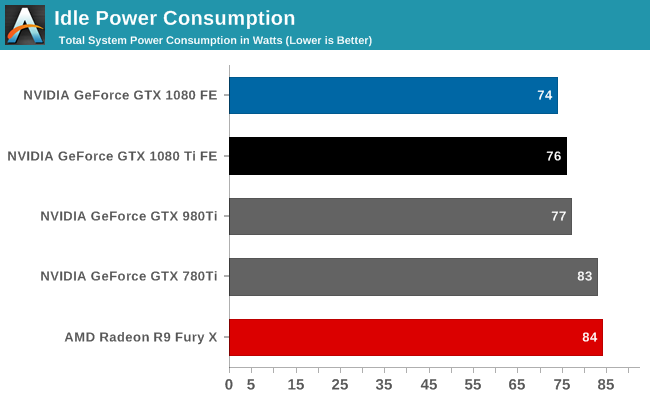
Moving on to power consumption, we’ll start as always with idle power. All told, there are no surprises here. GTX 1080 Ti’s idle power consumption is right next to GTX 980 Ti, which is where we’d expect it given the 250W design.
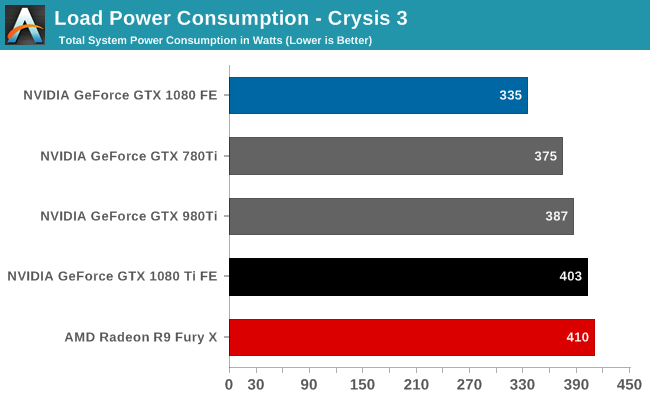
System power consumption under Crysis 3 is also right where we’d expect it to be for the GTX 1080 Ti. In absolute terms it’s second only to the R9 Fury X – which is to say that it’s high – but as Crysis 3 is a real-world test, power numbers here are influenced by the rest of the system. The faster the card, the more work required of the CPU, RAM, etc, and that’s exactly what’s happening here.
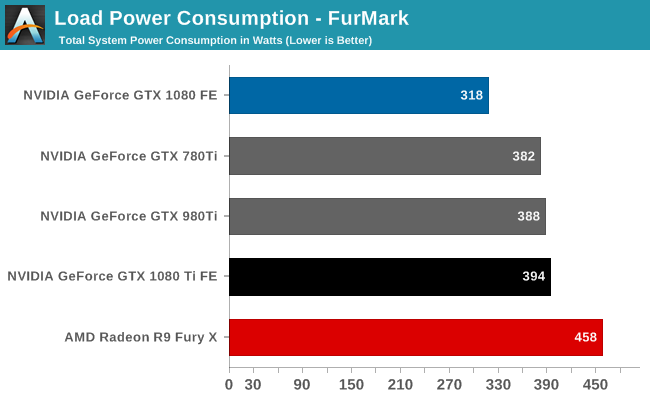
Switching over to FurMark, which is a much more GPU-focused test, we find that our GTX 1080 Ti-equipped testbed draws 394W at the wall. This is a smidge higher than the GTX 980 Ti, but not meaningfully so. All 3 250W NVIDIA cards are closely clustered together, showing that NVIDIA’s power throttling is working as expected, and at the levels expected. GTX 1080 Ti is rated for 70W higher than the GTX 1080, and our results back this rating up. With NVIDIA’s well-established power/performance tiers, GTX 1080 Ti makes the expected leap in power consumption in order to reach its loftier performance target.
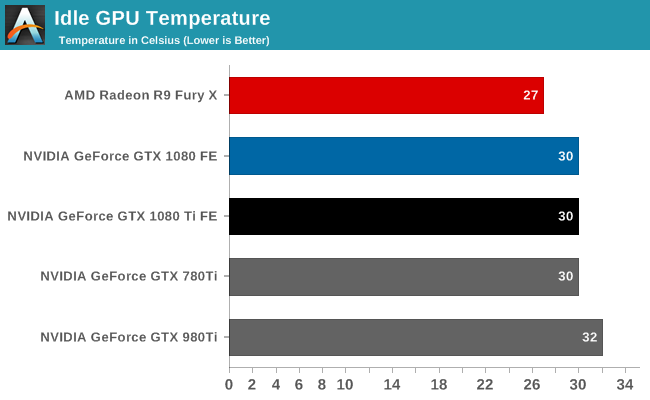
Moving on to temperatures, at idle the GTX 1080 Ti settles at 30C, the same as its siblings.
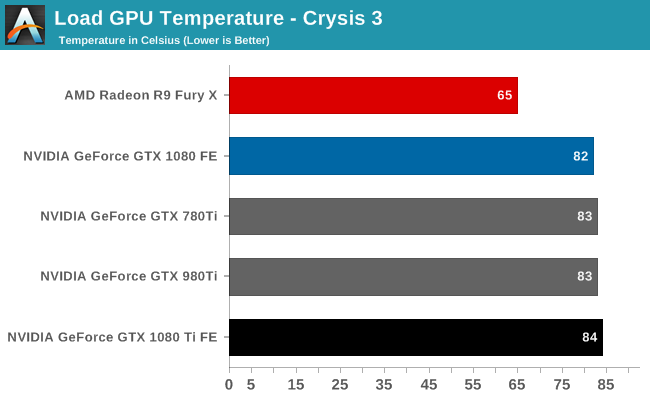
As for Crysis 3, the GTX 1080 Ti ends up being the hottest card here despite the cooling improvements, though it should be noted that this is intentional. While NVIDIA doesn’t publish this information directly, the GTX 1080 Ti’s preset thermal throttle point is 84C, which is a degree or two higher than on NVIDIA’s previous cards. As a result, the card reaches equilibrium at a slightly higher temperature than NVIDIA’s other cards.
It’s interesting to note that the throttle point has been slowly creeping up over the years; going back to the original Titan, it was only 80C. As far as reference specification designs go, the higher temperatures improve the efficiency of the cooler. The downside to higher temperatures is that power leakage increases with the temperature. So there’s a careful balancing act here in getting better cooling performance without drowning it out in more leakage-induced heat. In the case of the GTX 1080 Ti, I suspect NVIDIA paid their dues here with the additional MOSFETs, giving them a bit more headroom for leakage.
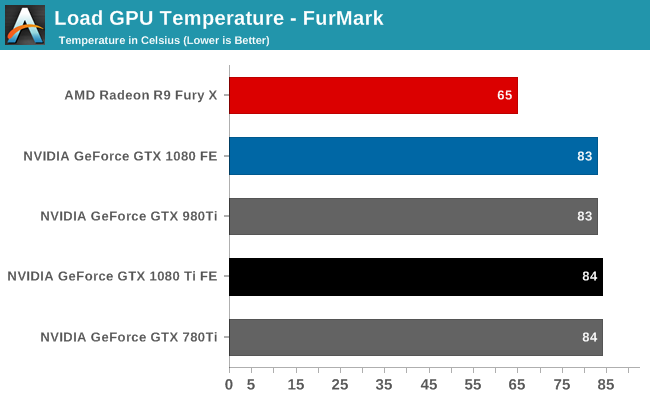
The story is much the same under FurMark. The GTX 1080 Ti settles at 84C here as well – though it did peak at 86C before reaching equilibrium – showcasing that regardless of the workload, the card always levels out at its thermal throttling point.
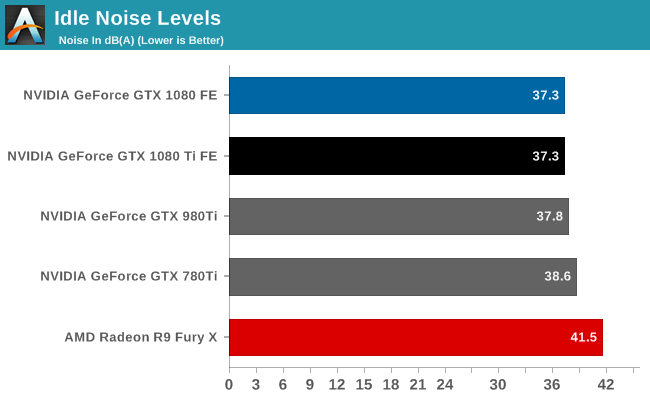
Finally we have our look at noise, starting with idle noise. Relative to the GTX 1080 NVIDIA has tweaked the fan curve a bit here, but at idle the GTX 1080 Ti is already below our noise floor.

Moving over to Crysis 3, we find that the GTX 1080 Ti holds a small edge over our other 250W TI-series cards. NVIDIA’s latest card hits 50.3dB, about 1.5dB below the GTX 980 Ti and GTX 780 Ti. This won’t make much of a difference, but it does close the gap between the 250W cards and the GTX 1080 by a bit.
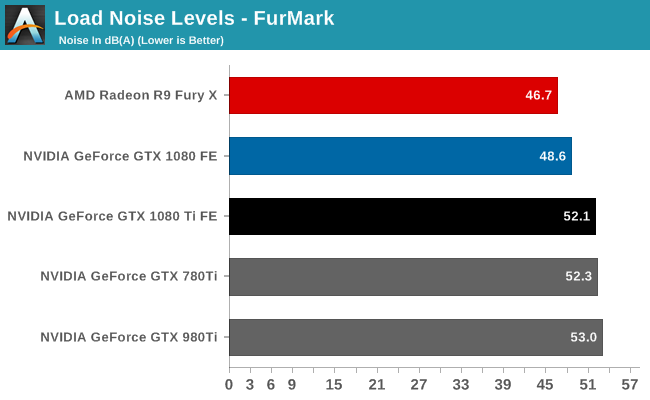
Finally, the situation with FurMark is much the same. The GTX 1080 Ti is still ever so slightly quieter than the other 250W NVIDIA cards, but a few dB louder than the GTX 1080.
Overall, judging from the power and noise characteristics of the GTX 1080 Ti, along with its throttling practices, it looks like NVIDIA invested most of their gains with the improved cooling system in removing more heat from the card itself. With few exceptions, the GTX 1080 Ti thermal throttles before it TDP throttles, and anecdotally, it tends to be closer to its TDP limit than most of the other high-end NVIDIA cards we’ve seen in the past couple of years.
Going back to what NVIDIA said earlier, they are claiming that the GTX 1080 Ti offers the largest performance uplift over its non-TI counterpart. Given that the TDP gap between the GTX 1080 Ti and GTX 1080 is actually smaller than the gap between the GTX 980 Ti and GTX 980 Ti – 70W versus 85W – if anything we’d expect this to be smaller. But by investing their gain from the improved cooler in better heat removal, NVIDIA is actually getting the GTX 1080 Ti closer to its performance/TDP limit than the previous generations of Ti cards. The only downside here is that you can only remove the DVI port once, so this isn’t an act that NVIDIA will be able to repeat in the next generation.










161 Comments
View All Comments
ddriver - Friday, March 10, 2017 - link
Also, granted, there are some amd optimized games, albeit few and far in between. But that doesn't excuse what nvidia does, nor does it justify it.Besides it was nvidia who started this practice, amd does simply try its best to balance things out, but they don't have nowhere nearly the resources.
amd optimized games are so rare, than out of my many contacts in the industry, I don't know a single one. So I cannot speak of the kinds of terms amd offers their assistance. I can only do that for nvidia's terms.
If amd's terms for support are just as exclusive as nvidia's, then amd is being guilty too. But even then, that doesn't make nvidia innocent. It makes amd guilty, and it makes nvidia like a 100 times guiltier.
eddman - Friday, March 10, 2017 - link
What terms? Are we back to "If we help, you cannot optimize your game for AMD"? How do you know there are such terms?Also, you said the entire helping out thing is illegal, terms or no terms. Now it's illegal only if there are certain terms?
ddriver - Friday, March 10, 2017 - link
Read the reply above. nvidia doesn't state the terms, because that would be illegal, the terms are implied, and they refuse further support if you break them... and worse... so it is a form of legal briberyand since their drivers are closed source, any hindrances they might implement to hamper your software remain a secret, but hey, there is a good reason why those drivers keep getting more and more bloated
eddman - Friday, March 10, 2017 - link
What if is nothing implied? Why are you so sure something must be implied if they're helping a dev? What if they simply want that game to work best with their hardware because it's an important game in their mind and might help sell some cards?We are heavily into guessing and assuming territory.
I'm not saying shady stuff doesn't happen at all, but to think that it happens all the time without exception would be extreme exaggeration.
ddriver - Friday, March 10, 2017 - link
There is no "nothing implied". It doesn't take a genius to figure what nvidia's motivation for helping is. Of course, if it is an important, prominent title, nvidia might help out even if the studio optimizes for amd just to save face.But then again, nvidia support can vary a lot, it can be just patching up something that would make them look bad, it can be free graphics cards and strippers as in the case of our lad above. I am sure he didn't optimize for amd. I mean that developers don't really care all that much how well their software runs, if it runs bad, just get a faster gpu. They care about how much pampering they get. So even in the case of a studio which is too big for nvidia to blackmail, there is still ample motivation to please it for the perks which they won't be getting from amd.
There is no assuming in what I say. I know this first hand. nvidia is very kind and generous to those willing to play ball, and and very thuggish with those who don't. So it doesn't come as a surprise if most of the developers chose to be on its good side. The more you please nvidia, the more you get from it, if tomorrow you apply for a job, and there is a sexy chick competing for the position, it can get the job by blowing the manager, and even if you would too, he is not into guys. You are not in the position to compete, and it is an unethical thing that wins her the job. U happy about it?
eddman - Friday, March 10, 2017 - link
You know this first hand how? You are claiming a lot and providing nothing concrete.eddman - Friday, March 10, 2017 - link
I already listed the motivation. Game runs good on their cards. People buy their cards.cocochanel - Saturday, March 11, 2017 - link
I don't understand your stubbornness. What ddriver is alluding to is questionable practices. In a free market system, fierce competition and all that, it becomes the norm. But it doesn't make it right. Free markets, you know, are like democracy. And you probably know what good old Winston had to say about that.eddman - Saturday, March 11, 2017 - link
No, he's outright calling such partnerships illegal. He claims to have "first hand" info but reveals nothing.Hardware companies working with software studios has been going on for decades. It wasn't illegal then and it isn't now.
DMCalloway - Saturday, March 11, 2017 - link
Agreed. Had Intel been fined the true value of what it gained with global dominance over the next 10+ years, things would be vastly different in Sunnyvale right now. So much so I would even speculate that Green team's only hope of viability would have come in the form of an acquisition on Blue team's part.